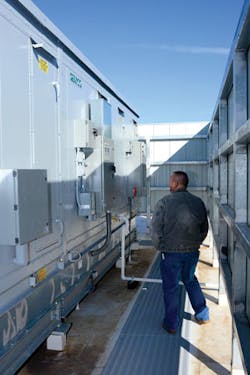Chilled Beams, DOAS Turn Old Factory Into LEED Gold Education Building
Looking to double the space for its machining and continuing-education programs, Randolph Community College (RCC) in Asheboro, N.C., purchased a 46,000-sq-ft uninsulated brick shell that once served as a furniture plant with plans to turn it into a high-efficiency educational facility, the Continuing Education and Industrial Center (CEIC).
With encouragement from RCC Director of Facilities Cindi Goodwin, Steve Campbell, PE, president, and Scott Ennis, PE, project engineer, of Raleigh, N.C.-based PDC Engineers thought well beyond convention, designing one of the nation’s first combinations of active chilled beams and an off-peak-hours ice-storage/chilled-water loop.
The foundation of the CEIC’s cooling system is 184 IQHC active chilled beams and two Pinnacle dedicated outdoor-air systems (DOAS) from SEMCO LLC. The chilled-water loop is supplied by a 130-ton CGAM air-cooled liquid chiller from Trane and an ice-storage system from CALMAC.
The two-pipe chilled beams, which range from 2 ft to 10 ft in length, supply 100 percent of the $7.6 million facility’s cooling. The DOAS delivers dry outdoor air to the chilled beams to prevent condensation and comply with ANSI/ASHRAE Standard 62.1, Ventilation for Acceptable Indoor Air Quality. The comparatively small 6-in.-diameter ductwork saves significant ceiling space.
“We wanted to keep ceiling heights at 10 ft,” Ennis said.
The chilled beams use approximately 40 percent less fan horsepower than a conventional rooftop-unit-and-ductwork system.
The two 10,000-cfm DOAS use molecular-sieve enthalpy-wheel technology to dehumidify outdoor air and recover heat from exhaust air. Compared with silica-gel desiccant wheels, the DOAS molecular-sieve technology quickly adsorbs the moisture, but not the contaminants, of exhaust air. Acid-resistant, antimicrobial, and anti-stick coatings on the enthalpy wheels help to prolong equipment life and maintain design static pressure.
The CEIC’s comprehensive energy savings result in a payback of six years—four years if a $60,000 utility rebate from Duke Energy is taken into account. The rebate was offered because the CEIC’s chiller operates mostly at night and is needed rarely, if at all, during daytime high-peak rate periods.
The building also features:
• Variable-frequency drives (VFD) on the piping loops and DOAS fans.
• High-output T-8 fluorescent lighting by Philips with occupancy sensors from WattStopper.
• Variable-air-volume (VAV) boxes with their own dedicated hot-water loop.
• A solar domestic-hot-water heating system from Lochinvar LLC.
• A 3,200-gal. rainwater-harvesting tank.
• For piping runs less than 3 in. in diameter, polypropylene pipe from Aquatherm.
The CEIC also uses a separate hot-water loop and VAV-box hot-water coils supplied by two Lochinvar condensing boilers and VFD-controlled Bell & Gossett pumps from Xylem Inc. Specifying a separate heating loop saved tens of thousands of dollars in installation labor and material costs, as opposed to piping hot water to each chilled beam.
RCC is saving 28.2 percent more than it would with a more conventional design.
The HVAC equipment will help RCC earn approximately seven credits toward LEED Gold certification.
RCC promotes the building’s energy savings with an EcoRate Web-based performance dashboard from BuildingLogix. The wall-mounted dashboard in the CEIC lobby allows visitors touchscreen access to real-time analysis of water and energy savings.
For Design Solutions author guidelines, call Scott Arnold, executive editor, at 216-931-9980, or write to him at [email protected].


